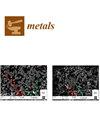关于调整 B2 Nb50-xTixRu50 形记忆合金马氏体转变以实现结构应用的初步原理研究
IF 2.5
3区 材料科学
Q3 MATERIALS SCIENCE, MULTIDISCIPLINARY
引用次数: 0
摘要
NbRu 具有高温形状记忆合金(HTSMA)的潜力,因为它的马氏体转变温度高于 1000 ℃。不过,它的形状记忆特性还需要改进,以便用于航空航天和汽车工业。形状记忆性能不理想可能与脆性四方 L10 马氏体相的存在有关。因此,为了改变 B2→L10 的转变路径,优先选择 B2→ 正交或 B2→ 单斜(MCL)相,本研究考虑添加 B2 相稳定剂钛(Ti),以部分替代铌(Nb)原子。我们进行了 ab initio 计算,以研究添加 Ti 对 B2 和 L10 相 Nb50-xTixRu50 的热力学、弹性和电子特性的影响。结果表明,随着钛含量的增加,B2 和 L10 相的稳定性相当。此处提供的模拟数据足以帮助选择合适的成分,从而将 L10 相工程化。上述成分的钛含量在 15-30% 之间。在设计用于 200 °C 以上高温环境下的结构合金时,可以考虑使用这些成分。本文章由计算机程序翻译,如有差异,请以英文原文为准。
First-Principle Study on Tailoring the Martensitic Transformation of B2 Nb50−xTixRu50 Shape-Memory Alloy for Structural Applications
NbRu has a potential as a high-temperature shape-memory alloy (HTSMA) because it has a martensitic transformation temperature above 1000 °C. However, its shape-memory properties could be improved for consideration in the aerospace and automotive industry. The unsatisfactory shape-memory properties could be associated with the presence of a brittle tetragonal L10 martensitic phase. Therefore, in an attempt to modify the transformation path from B2→L10 in preference of either B2→orthorhombic or B2→monoclinic (MCL), an addition of B2 phase stabiliser, titanium (Ti), has been considered in this study to partially substitute niobium (Nb) atoms. The ab initio calculations have been conducted to investigate the effect of Ti addition on the thermodynamic, elastic, and electronic properties of the Nb50−xTixRu50 in B2 and L10 phases. The results showed that the B2 and L10 phases had comparable stability with increasing Ti content. The simulated data presented here was sufficient for the selection of suitable compositions that would allow the L10 phase to be engineered out. The said composition was identified within 15–30 at.% Ti. These compositions have a potential to be considered when designing alloys for structural application at high temperatures above 200 °C.
求助全文
通过发布文献求助,成功后即可免费获取论文全文。
去求助
来源期刊

Metals
MATERIALS SCIENCE, MULTIDISCIPLINARY-METALLURGY & METALLURGICAL ENGINEERING
CiteScore
4.90
自引率
13.80%
发文量
1832
审稿时长
1.5 months
期刊介绍:
Metals (ISSN 2075-4701) is an open access journal of related scientific research and technology development. It publishes reviews, regular research papers (articles) and short communications. Our aim is to encourage scientists to publish their experimental and theoretical results in as much detail as possible. Therefore, there is no restriction on the length of the papers. The full experimental details must be provided so that the results can be reproduced. Metals provides a forum for publishing papers which advance the in-depth understanding of the relationship between the structure, the properties or the functions of all kinds of metals.
 求助内容:
求助内容: 应助结果提醒方式:
应助结果提醒方式:


